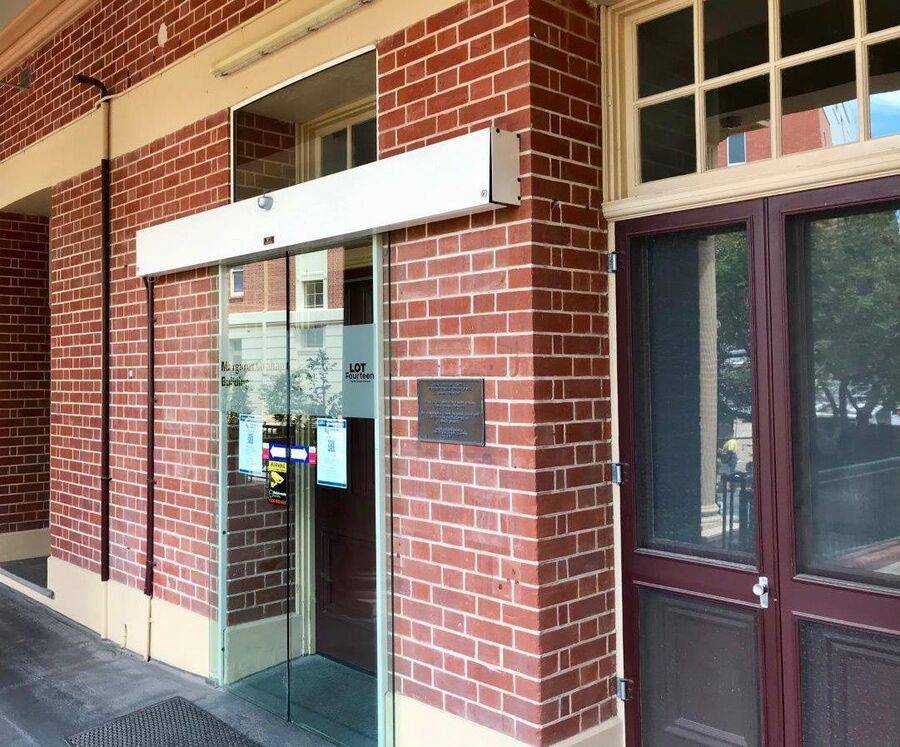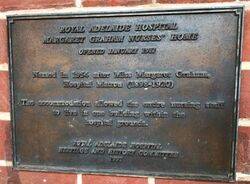
Margaret GrahamPrint Page 
The Margaret Graham Building commemorates Margaret Graham (15 February 1860 – 4 July 1942) who was a nurse.
She was a nurse at the centre of a dispute dubbed the "Adelaide Hospital Row" at the (later Royal) Adelaide Hospital in 1894. She overcame this dubious distinction to become the highly regarded Matron of the hospital, then one of the first Australian nursing Matrons to serve at the front during World War One.
Graham was born in Carlisle, Cumberland, England, and nothing is known of her early life until she emigrated to South Australia in 1886 and on 2 April 1891 enrolled as a probationary nurse at the Adelaide Hospital. In March 1894 she was appointed acting charge nurse of the Adelaide ward, and on 19 November was recommended by the hospital board for appointment as night charge nurse. This recommendation was not implemented.
Adelaide Hospital at that time was a dysfunctional workplace, beset with factional jealousies and professional rivalries, exacerbated by opponents of the Government, who saw political benefit in keeping the hospital an "open sore"] Graham became embroiled in controversy when nurse Gordon (1861–1940), a sister of the Chief Secretary John Gordon was promoted to Superintendent of Night Nurses, the second highest nursing rank. Many nurses thought the position should have gone to the more senior charge nurse Louise Hawkins, and that this was a case of favoritism. Six nurses, Graham among them, sent a petition to Premier Charles Kingston requesting an independent enquiry.
A committee of twelve, met to consider the Premier's request for a review of the appointment. This they endorsed on the grounds that Miss Gordon's selection was on her leadership potential, not her nursing ability. Also they regarded the letter as insulting and impertinent, and recommended suspension of the signatories. Under pressure, five of the nurses withdrew their support for Hawkins, but Graham refused to retract and was urged by her superior, Matron McLeod, to resign.
A Royal Commission found that her protest was justified, but insulting terms had been used against the Government and the Hospital Board, and if these were retracted Graham should be reinstated. Graham was appointed charge nurse and put in charge of Wyatt Ward on 4 March 1896.] She soon lived down her reputation as a rebel by dedication to her profession, and was appointed Matron on 1 January 1898.
In November 1911, in an echo of 1895, three nurses were sacked by the board for complaining about the conduct of one Sister Dunstan, who was responsible to Matron Graham. Subsequently 81 nurses refused to work under her; Graham informed the medical superintendent, Dr.C. de Crespigny who ordered them to work in the Victoria Ward under Sister Dunstan, and all but two probationers refused and were suspended. Graham smoothed the way for the nurses to return to work, advising them they would not be required to serve under Dunstan.
In 1904 she enlisted with the Australian Army Nursing Service, a newly formed volunteer body of 108 (14 in SA) women nurses attached to the Australian Army Medical Corps and Graham was appointed the State's Lady Superintendent. Graham enlisted for active service with the Australia Imperial Force in September 1914. With some 2,000 troops she boarded Ascanius ( Transport A11), which left Port Adelaide on 20 October 1914.
Graham served at the 2nd Australian General Hospital at Mena House, Heliopolis on 27 April 1915, and then in May 1915 at the 1st Australian General Hospital in Heliopolis who she served in 1915 and 1916. She returned to Melbourne on duty aboard hospital transport ship Euripides, leaving Suez 22 January 1917. She reenlisted on 2 April 1917 and returned to London, reporting for duty at the 3rd Australian Auxiliary Hospital in Dartfor, Kent which specialised in war neurosis. Her last posting was the 2nd Australian General Hospital, England, before in January 1918 reporting to the medical offices at A.I.F. Headquarters, London. She was a few months in the Glen Almond Convalescent Home for Sisters, then returned to Australia, and admitted to the 7th Australian General Hospital in June 1918 and discharged as an invalid in August 1918.
Graham rejoined the Adelaide Hospital staff, then in 1919 was seconded to the Jubilee Exhibition Building on North Terrace, Adelaide which had been requisitioned by the Army as a convalescent hospital for military victims of the influenza pandemic. She resigned in 1920 and in January 1921 boarded the ship Benalla for England where she died in Carlisle.
Location
| Address: | 1A Frome Street, Margaret Graham Building, Adelaide, 5000 |
|---|---|
| State: | SA |
| Area: | AUS |
| GPS Coordinates: | Lat: -34.920291 Long: 138.608133 Note: GPS Coordinates are approximate. |
Details
| Monument Type: | Structure |
|---|---|
| Monument Theme: | People |
| Sub-Theme: | Medicine |
Dedication
| Approx. Monument Dedication Date: | 1992 |
|---|
Plaque :
Royal Adelaide Hospital
Margaret Graham Nurses` Home
Opened January 1911
Named in 1954 after Miss Margaret Graham, Hospital Matron ( 1898 - 1920 )
The accomodation allowed the entire nursing staff to live in one building within the hospital grounds.
Royal Adelaide Hospital Heritage and History Committee
1992






